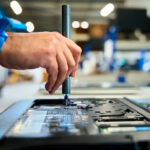Extending the life of your equipment: the guide to centralised maintenance of your IT assets
IT maintenance, a tool for regaining control of your product roadmaps
Did you know? The average lifespan of a smartphone is 18 months, and 3 years for a PC in the workplace! This period of use is dictated by manufacturers’ roadmaps (end of manufacturer’s warranty, end of equipment production, end of availability of spare parts, etc.) but can be extended if you choose to have your equipment repaired.
You’ll avoid having to replace your units prematurely, and you’ll be helping to reduce the environmental impact of manufacturing new equipment and producing electronic waste.
Choosing to centralise IT asset maintenance on a one-off or long-term basis is also a first step towards a more ethical approach to managing your IT assets.
Why centralise your IT maintenance?
- Extend the lifespan of your fleet
- Maintain a uniform fleet
- Reduce your consumption of new equipment
- Save resources and reduce the production of WEEE
- Ensure GDPR compliance
- Optimise your management costs (project management / deployment / training)
A word from Flavien Amey, Founder and CEO of ToucheDeClavier.com
“Repair is a major factor in extending the lifespan of IT equipment. From an ecological point of view, repair will always be more beneficial to our environment because we avoid producing new products and scrapping them (creating WEEE).”
Repairing a laptop is a simple, reliable and sustainable task, but above all it’s cost-effective because it’s often cheaper than replacing the product with a new one. To go one step further in reducing the digital footprint of your repairs, you can also opt for refurbished spare parts, which offer the same level of service and warranty as new parts.
5 steps to centralising your IT maintenance services
1. Choose a partner near you
To limit delays and the environmental impact of transport, and to encourage growth in your region, choose a partner that is close to home, or at least local.
By using local companies, you can be sure that the repairs carried out will be rigorous, as they must comply with a strict legal framework for the refurbishing of electronic equipment.
Choosing a local partner also gives you the opportunity to build up a real relationship and to visit the premises for a better understanding of the repair process for your equipment.
2. Prefer a multi-brand, multi-range one stop shop
If you have deployed a heterogeneous fleet of barcode or POS terminals, it’s best to call on a repair company that can handle equipment of all makes and models.
It saves time, money and simplifies management!
3. Opt for targeted maintenance
Rugged terminals do not have the same maintenance needs as indoor or VIP equipment. Choose a partner who will be able to advise you on maintenance adapted to your equipment and who will take into account all aspects of your business: usage, breakdown rate, types of breakage etc.
4. Demand traceability
When it comes to managing your IT assets, transparency and traceability are key.
Ask your service provider to keep precise track of all your equipment by IMEI for smartphones or serial number, repairs carried out, data security and recycling of materials.
5. Protect your fleet against breakage
There are 10 times more breakages than thefts or losses. By protecting your equipment, you can limit the risk of your units falling and/or breaking. Depending on your sector of activity, your working environment may be more or less hostile. Choose the right accessories to guarantee the safety of your equipment.
Our advice
You can reduce the carbon footprint of your repairs even further by using second-hand spare parts. Tested and guaranteed, they guarantee the same level of quality with an even lower environmental impact!
What is the scope of your IT repairs?
Because maintenance can be seen as a headache for fleet managers, some choose to systematically replace equipment or entrust repairs to their employees. Find out which equipment is eligible for repair:
- Barcode scanner
- Checkout
- Payment terminal
- Printer
- Infrastructure and networks
- Headset
- Software
- Smartphone
- Tablet
- Telephone
- Computer
- Laptop
- Screen




